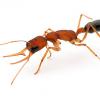1. Location (on a map) of collection: Cave Creek, AZ
2. Date of collection: 5/25/20
3. Habitat of collection: Desert Scrub
4. Length (from head to gaster): 7 mm
5. Color, hue, pattern and texture: Orange-Red, small black stripes on gaster
6. Distinguishing characteristics: Fairly large eyes relative to head size
7. Distinguishing behavior: NA
8. Nest description: NA
9. Nuptial flight time and date: NA
Images:


1. Location (on a map) of collection: Cave Creek, AZ
2. Date of collection: 5/26/20
3. Habitat of collection: Desert Scrub
4. Length (from head to gaster): 5 mm
5. Color, hue, pattern and texture: Very dark brown with black gaster
6. Distinguishing characteristics: Very large gaster relative to body size
7. Distinguishing behavior: NA
8. Nest description: NA
9. Nuptial flight time and date: NA
Images:
























